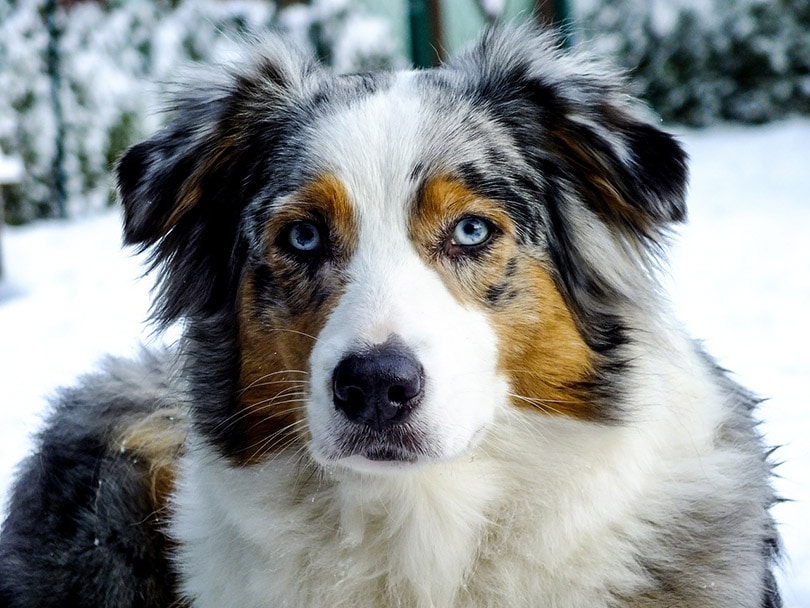Miniature Australian Shepherd vs Australian Shepherd: The Differences (With Pictures)
Updated on

Click to Skip Ahead
The Australian Shepherd is a breed well known for its intelligence, loyalty, and high energy. These attributes have led to the Aussie becoming one of America’s most popular dog breeds. If you’re considering purchasing or adopting an Australian Shepherd, you might be trying to decide between the Miniature Australian Shepherd and the Australian Shepherd.
While there aren’t that many differences between them, other than their size, there are a few that we’ll discuss in the guide below. Hopefully, by the end of this guide, you’ll be able to decide which of these gorgeous dogs is the right choice for you and your family.
Visual Differences

At a Glance
- Average height (adult): 15–18 inches
- Average weight (adult): 22–44 pounds
- Lifespan: 12–15 years
- Exercise: 1+ hours a day
- Grooming needs: Moderate
- Family-friendly: Yes
- Other pet-friendly: Often
- Trainability: Intelligent, loyal, eager to please
- Average height (adult): 18–23 inches
- Average weight (adult): 51–64 pounds
- Lifespan: 1–18 years
- Exercise: 1–2 hours a day
- Grooming needs: Moderate
- Family-friendly: Yes
- Other pet-friendly: Often
- Trainability: Intelligent, loyal, eager to please
Miniature Australian Shepherd Overview

The miniature Australian Shepherd reaches around 15 to 18 inches in height and weighs 22 to 44 pounds by adulthood. They have a life expectancy of 12 to 15 years. They are sweet, loyal dogs that are eager to please their pet parents. We’ll discuss their personality, health issues, and more in the section below.
Personality
The Miniature Australian Shepherd is very similar to its larger counterpart regarding the dog’s personality. They are both intelligent, loyal, and eager to please their owners. The breed is athletic and known for its protective nature as well.
You should expect your Mini Aussie to act out if it feels that you or your kids are being threatened. It is a loyal breed that’s easy to train.
Exercise
It’s recommended that your little Aussie get around one hour of exercise daily. This needs to be done in short bursts, so the Aussie doesn’t get too tired, but they are pretty energetic.

Training
The Mini Australian Shepherd is easy to train, though the breed is strong-willed, so you’ll want to start early with its training and socialization. It’s important to note that this dog doesn’t like to be bored, and you can train it to behave when you’re not home for the best results, or the dog can become destructive.
Health and Care
As with any pet, the Mini Aussie has possible health issues. The dog is a relatively healthy breed, but you need to watch out for hereditary conditions such as hip dysplasia, degenerative myelopathy-spinal disease, progressive retinal atrophy, and other eye conditions such as cataracts.
If you see the symptoms of any of these conditions in your Mini Aussie, it’s best to get it to the vet right away for a checkup to treat the condition. Regular vet visits will also help catch these diseases and conditions before they become a serious problem.

Breeding
These little dogs were originally bred in California in the 1960s to herd cattle. It didn’t take long before the adorable little dogs were seen as pets, and they became popular soon after due to their loyal, protective, and affectionate natures.
These little dogs are workaholics and need to be with an active and energetic family. The breed is also AKC-recognized.
Suitable for:
Mini Aussies are suitable for most families, as they are energetic, love to play, and will protect your family from harm. However, they are said not to be the best choice for a first-time pet owner, as they can be rambunctious and are strong-willed.
Australian Shepherd Overview

The Standard Australian Shepherd is much like the Mini Australian Shepherd in many ways. Most of the differences between the two are because of the size. Standard Aussies reach 18 to 23 inches in height and top out at between 51 and 64 pounds by adulthood.
They have an average lifespan of 12 to 18 years. They are loyal, eager to please, and intelligent, much like the Mini Aussie.
Personality
The Standard Aussie is loyal, loving, affectionate, and protective, just as the Mini Aussie is. Just like their counterparts, they are non-aggressive unless something threatens their families; they will become aggressive if necessary.
Their eager-to-please nature makes them one of the favorite dog breeds for families. They are energetic, so make sure you have the time to play with this dog, just as you would the Mini Aussie.
Exercise
The Standard Aussie needs between one and two hours of exercise a day. They love going to parks, playing frisbee and ball, and basically doing anything with their owners. Daily exercise will keep the Aussie from becoming bored or destructive.

Training
Just like the Mini Aussie, the Standard Aussie is easy to train but can be strong-willed. You’ll want to start its training and socialization early on for the best results.
Health and Care
The Standard Aussie has a few health conditions to watch out for, though it’s a pretty healthy breed. Those conditions include heart conditions, epilepsy, hearing and vision problems, hip dysplasia, and severe allergies.
As with the Mini Aussie, you should look for signs of these conditions and get your dog to a vet for diagnosis and treatment if you feel the dog is sick.

Breeding
Believe it or not, the Aussie does not come from Australia. Their ancestors were European, but the breed was perfected in California. They were bred for herding but are now well-known for being excellent companion animals.
Suitable for:
Just as with the Mini Aussie, the Standard Aussie does excellent as a family pet. They aren’t great for first-time pet owners due to their energetic nature and strong will. If you adopt an Aussie, make sure you have the time to spend with it before you commit to giving it a forever home.
Which Breed Is Right for You?
While there are very few differences between the Miniature Australian Shepherd and the Standard Australian Shepherd, there are enough differences to make it hard to choose. Of course, the Standard Aussie is larger than the Mini Aussie and outweighs it.
It comes down to which dog you think will be the best choice for you and your family. Do your research, visit a few breeders, then decide which one will be the best choice for you and your family based on the facts you find.
Featured Image Credit: (L) otsphoto, Shutterstock | (R) Fotoschauer, Shutterstock














